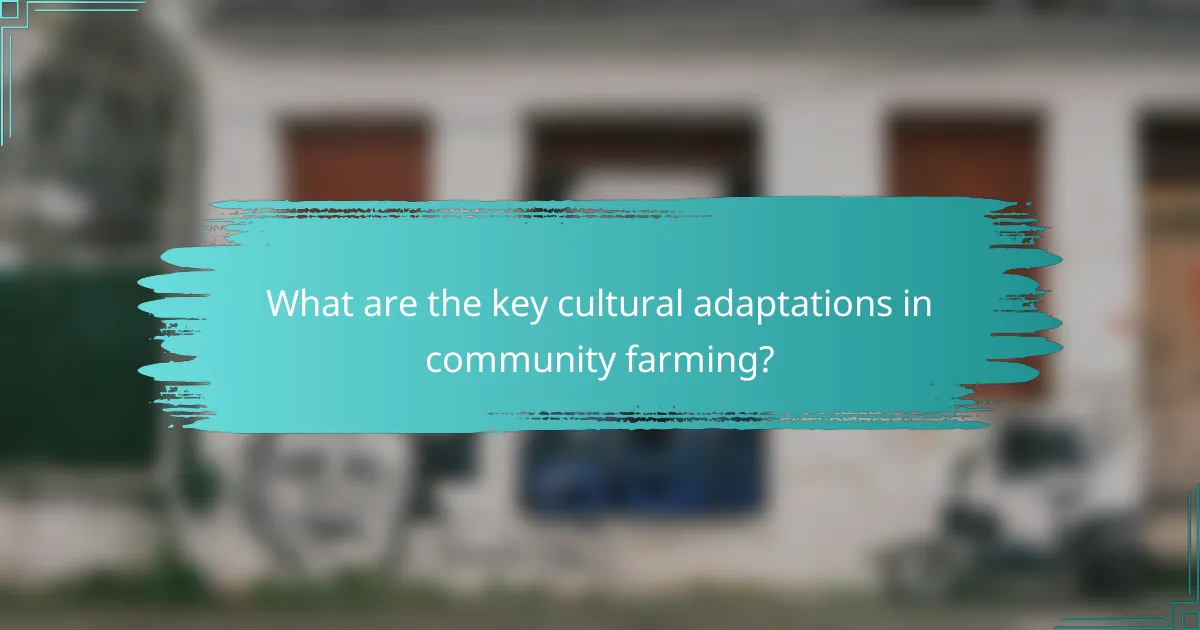Community farming models serve as a vital tool for enhancing sustainability in urban environments by encouraging local food production and reducing environmental impacts. By integrating cultural adaptations and fostering community engagement, these initiatives not only align agricultural practices with local traditions but also empower residents to take ownership of their food systems, ultimately leading to more resilient and effective farming practices.

How do community farming models enhance sustainability in urban areas?
Community farming models significantly enhance sustainability in urban areas by promoting local food production, reducing environmental impact, and fostering community engagement. These models create a more resilient food system that benefits both the environment and local residents.
Increased local food production
Community farming increases local food production by utilizing urban spaces for growing fruits, vegetables, and herbs. This practice reduces reliance on imported goods, which often travel long distances, and helps ensure that fresh produce is available to local residents.
Urban farms can vary in size from small backyard gardens to larger community plots, often yielding enough food to supply local markets or food banks. Engaging community members in the farming process fosters a sense of ownership and responsibility towards food sources.
Reduction of carbon footprint
By growing food locally, community farming models contribute to a significant reduction in carbon footprint associated with transportation and distribution. When food is sourced from nearby farms, the emissions linked to long-distance shipping are minimized.
Additionally, urban farms often implement sustainable practices such as composting and organic farming, which further lower greenhouse gas emissions. Encouraging residents to participate in these practices can amplify their impact on urban sustainability.
Promotion of biodiversity
Community farming promotes biodiversity by introducing a variety of plants and crops into urban environments. This diversity supports local ecosystems, attracts pollinators, and helps maintain soil health.
Urban farms can serve as habitats for various species, contributing to a balanced ecosystem. Implementing permaculture principles can enhance these benefits by creating self-sustaining agricultural systems that mimic natural ecosystems.
Community resilience building
Community farming models build resilience by fostering social connections and networks among residents. These connections enhance community cohesion, making it easier to respond to challenges such as food insecurity or economic downturns.
Participating in community farming initiatives empowers individuals by providing skills and knowledge related to food production and sustainability. This empowerment can lead to greater community involvement in local decision-making processes, further strengthening resilience.

What are the key cultural adaptations in community farming?
Key cultural adaptations in community farming involve modifying agricultural practices to align with local traditions, knowledge, and environmental conditions. These adaptations enhance community engagement and promote sustainable farming methods that are culturally relevant and ecologically sound.
Integration of local agricultural practices
Integrating local agricultural practices means incorporating techniques and methods that have been traditionally used in the region. This can include crop rotation, intercropping, and the use of native plant species that are well-suited to the local climate. Such practices not only improve soil health but also increase resilience against pests and diseases.
Farmers should assess the historical farming methods of their community and consider how these can be adapted to modern techniques. For instance, using organic fertilizers derived from local resources can enhance sustainability while respecting cultural heritage.
Emphasis on traditional knowledge
Emphasizing traditional knowledge involves valuing the insights and experiences of local farmers, particularly elders who have a deep understanding of the land and its cycles. This knowledge can guide decisions on planting times, pest management, and crop selection, ensuring that farming practices are both effective and culturally appropriate.
Community workshops and storytelling sessions can facilitate the sharing of this knowledge among generations. Engaging younger farmers in these discussions can help preserve traditional practices while integrating innovative approaches.
Incorporation of diverse crops
Incorporating diverse crops is essential for enhancing biodiversity and food security within community farming. Growing a variety of crops can reduce the risk of total crop failure due to pests or adverse weather conditions. It also allows communities to cater to different dietary needs and preferences.
Farmers should consider planting a mix of staple crops, vegetables, and fruits that are culturally significant. For example, in Mediterranean regions, integrating olives, grapes, and various vegetables can reflect local culinary traditions while promoting ecological balance.

How does community engagement influence farming success?
Community engagement plays a crucial role in the success of farming initiatives by fostering collaboration and ownership among local stakeholders. When community members actively participate, they contribute valuable insights and resources, leading to more sustainable and effective farming practices.
Active participation in decision-making
Active participation in decision-making allows community members to voice their opinions and influence farming strategies. This can include voting on crop choices, resource allocation, and sustainability practices. Engaging locals ensures that decisions reflect the community’s needs and values, which can enhance commitment and reduce resistance.
To facilitate this, consider establishing regular meetings or forums where all stakeholders can discuss and vote on key issues. Utilizing digital platforms for remote participation can also broaden engagement, especially in larger communities.
Strengthening social ties
Strengthening social ties within the community enhances trust and cooperation, which are vital for successful farming operations. When individuals feel connected, they are more likely to collaborate on projects, share resources, and support each other during challenges.
Organizing community events, such as harvest festivals or potlucks, can help build these relationships. Additionally, creating small working groups for specific tasks can foster deeper connections and a sense of shared purpose among participants.
Educational programs for local youth
Implementing educational programs for local youth is essential for fostering a new generation of engaged community members. These programs can teach agricultural skills, environmental stewardship, and the importance of local food systems, ensuring that knowledge is passed down.
Consider partnering with schools or local organizations to develop hands-on workshops or internships on community farms. This not only equips youth with practical skills but also encourages them to take an active role in their community’s agricultural future.

What are the best practices for implementing community farming?
Effective community farming relies on several best practices that enhance collaboration, sustainability, and local engagement. These practices include establishing governance structures, forming partnerships with local organizations, and utilizing sustainable farming techniques.
Establishing clear governance structures
Clear governance structures are essential for community farming initiatives to function smoothly. These structures define roles, responsibilities, and decision-making processes among participants, ensuring that everyone is aligned with the community’s goals.
Consider forming a committee or board that includes representatives from diverse community groups. This can help balance interests and foster transparency in operations. Regular meetings and open communication channels are vital for maintaining engagement and addressing concerns.
Creating partnerships with local organizations
Building partnerships with local organizations can significantly enhance the resources and support available to community farms. Collaborating with schools, non-profits, and agricultural extension services can provide access to expertise, funding, and volunteers.
For example, partnering with a local school can facilitate educational programs about sustainable agriculture, while a non-profit might offer grants or technical assistance. Establishing these connections helps strengthen community ties and increases the farm’s impact.
Utilizing sustainable farming techniques
Sustainable farming techniques are crucial for ensuring the long-term viability of community farms. Practices such as crop rotation, organic pest management, and permaculture can enhance soil health and reduce environmental impact.
Implementing these techniques not only benefits the ecosystem but can also improve crop yields and reduce costs over time. Community farms should consider training sessions or workshops to educate participants on these methods, fostering a culture of sustainability.

What challenges do community farming models face?
Community farming models encounter several challenges that can hinder their effectiveness and sustainability. Key issues include limited access to funding and resources, navigating land use regulations, and resolving conflicts within the community.
Access to funding and resources
Securing funding and resources is a significant challenge for community farming initiatives. Many projects rely on grants, donations, or local government support, which can be inconsistent or insufficient. Establishing partnerships with local businesses and organizations can help diversify funding sources.
Community farms may also benefit from crowdfunding campaigns or membership models that encourage local investment. Engaging the community in fundraising efforts can foster a sense of ownership and commitment to the farm’s success.
Land use regulations
Land use regulations can pose barriers to community farming, as zoning laws often restrict agricultural activities in urban areas. Understanding local regulations is crucial for community farms to operate legally and sustainably. Farmers should consult with local authorities to clarify permissible activities and any necessary permits.
In some regions, community farms can advocate for policy changes that support urban agriculture, such as amending zoning laws or creating urban agriculture zones. Building relationships with local policymakers can facilitate these changes and promote a more favorable environment for community farming.
Community conflict resolution
Conflicts can arise within communities over land use, resource allocation, and differing visions for the farm. Effective communication and inclusive decision-making processes are essential for resolving these disputes. Establishing clear guidelines for participation and conflict resolution can help mitigate tensions.
Facilitating regular community meetings allows all voices to be heard and fosters a collaborative atmosphere. Involving a neutral mediator can also be beneficial for addressing deeper conflicts and ensuring that all parties feel respected and valued in the decision-making process.

How can community farming models be scaled in metropolitan areas?
Scaling community farming models in metropolitan areas involves utilizing available resources and engaging local populations. This can be achieved through innovative practices that maximize urban space and foster community involvement.
Leveraging urban green spaces
Urban green spaces, such as parks, rooftops, and vacant lots, can be transformed into productive community farms. These areas provide essential resources for growing food while enhancing local biodiversity and improving air quality.
To effectively leverage these spaces, city planners and community leaders should identify underutilized areas and assess their potential for agricultural use. Collaborating with local governments can help secure necessary permits and resources, ensuring compliance with zoning laws and regulations.
Examples include rooftop gardens on commercial buildings or community gardens in public parks. Engaging local residents through workshops and volunteer days can foster a sense of ownership and encourage sustainable practices.
